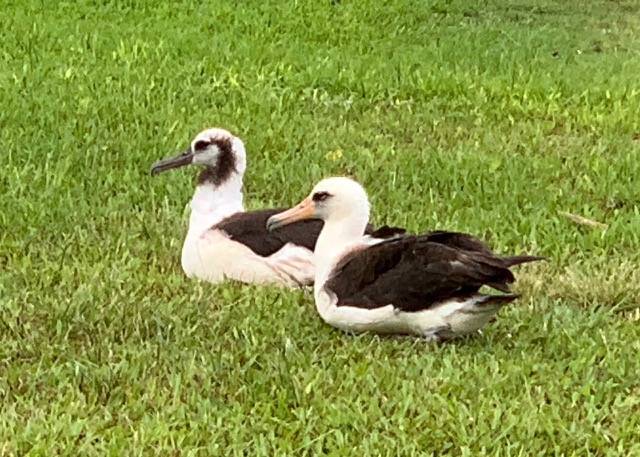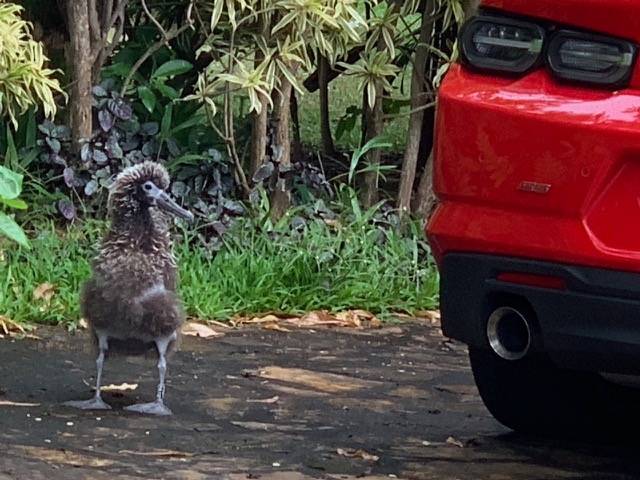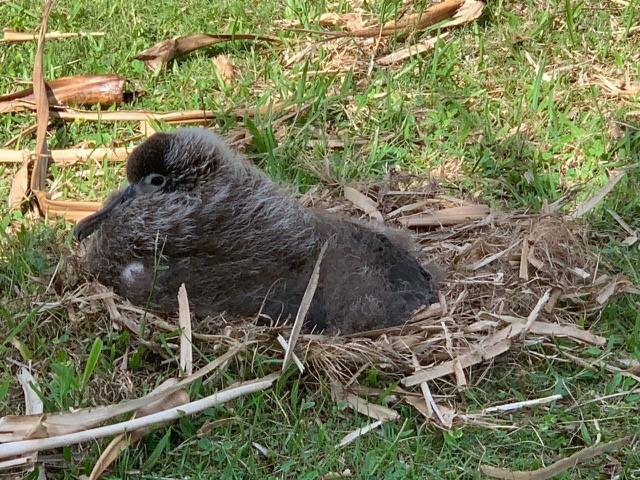PRINCEVILLE — Cathy Granholm has bid adieu to two of the 17 albatross chicks that have been growing up in her neighborhood for the past few months.
Another has fledged from Princeville’s Makai Golf Course.
They’re part of the first flight of fledglings leaving Kauai and taking wing for the first time. They won’t return for about three years. They won’t start breeding until they’re 7 or 8 years old.
“Nobody saw either one of them leave, but could see the ocean from the spots where they were sitting,” Granholm said.
Around the island, and throughout the state’s nesting sites, chicks have been taking the leap — usually from cliffs fronting the ocean — and heading toward Alaska for some fresh seafood.
Nests will soon start to empty at Kilauea Point National Wildlife Refuge and Na Aina Kai Gardens.
From James Campbell Wildlife Refuge on Oahu, Refuge Specialist Bethany Chagnon reports the one wild albatross chick on site is still a few weeks out from fledging.
“This is the first time in many years that an albatross chick has been successfully raised on the refuge, so we are excited that the chick is doing well,” Chagnon said. “It was a bit touch-and-go for a little while. The parents’ feeding schedule was more erratic, and their foraging trips were longer than we expected. This could be because they are a young pair and it takes time to become an effective parent.”
Out at Midway Atoll, wildlife biologist Kelly Goodale says black-footed albatross fledging started last week and will continue for the next couple of weeks.
“There may be a couple of early Laysan albatross that have fledged, but we have not documented any yet. Within the next week we will start to see the ones in our monitoring areas begin to venture further away. Earlier this year we had a short-tailed albatross chick which we presumed fledged in mid-to-late May,” Goodale said.
As far as the condition of the growing birds, Goodale says it’s looking like a good year at Midway, but scientists won’t know the status of the fledging season until after July, when they can compare data to previous years.
“The winter was really mild and we did not have bad rainstorms that typically submerge nests/chicks early on. So far the summer temperatures have been mild, which reduces the cases of heat exhaustion,” Goodale said.
There’s even a chick at the U.S. Navy’s Pacific Missile Range Facility at Barking Sands, where a translocation program has been ongoing to move a nesting colony from an active runway.
According to Tom Clements, spokesman for PMRF, staff are regularly keeping an eye on the bird.
“There are many variables that determine the order of fledging,” Granholm says. “It would be way too easy to predict that by when they hatch. These birds are much too complicated, and much too interesting to live their lives by such simple rules.”
In her neighborhood, she says the remaining albatross are “a varied bunch”.
They’re starting to develop unique features and feathers. Some still have an abundance of downy feathers and some have filled out with adult feathers. Most sport a mixture of both, lending to awkward-looking “hairstyles.”
Life is an adjustment for the adult albatrosses as well. Granholm recently witnessed a grown albatross returning from a foraging mission to find her chick had fledged.
So, she wandered over to another chick and sat next to him instead.
“Why? I have seen this happen a number of times. These birds spend so much time alone, out at sea, then come back here to live the social part of their lives. And often, faced with the choice of being alone or sharing a bit of lawn with another albatross, they choose the latter,” she said.
Fledging season begins in late June/early July and continues through August, sometimes a little later.
As they watch the fledglings take their first flights into adult life, scientists say the best thing they can do is make sure the albatrosses have a safe refuge to return to after spending almost 90% of their time at sea.
“One of the best things that we can do for Pacific seabirds like the albatross is work to provide optimal nesting habitat. This includes improving habitat they currently use and helping to create safe, new colonies on the higher islands in the face of sea-level rise and changing climates,” Goodale said.
“For a species that takes so long to reach reproductive age and produces a single chick in any given year, minimizing loss when they are here is the most important thing we can do that’s within our realm of control,” Chagnon said.
•••
Jessica Else, environment reporter, can be reached at 245-0452 or jelse@thegardenisland.com.





